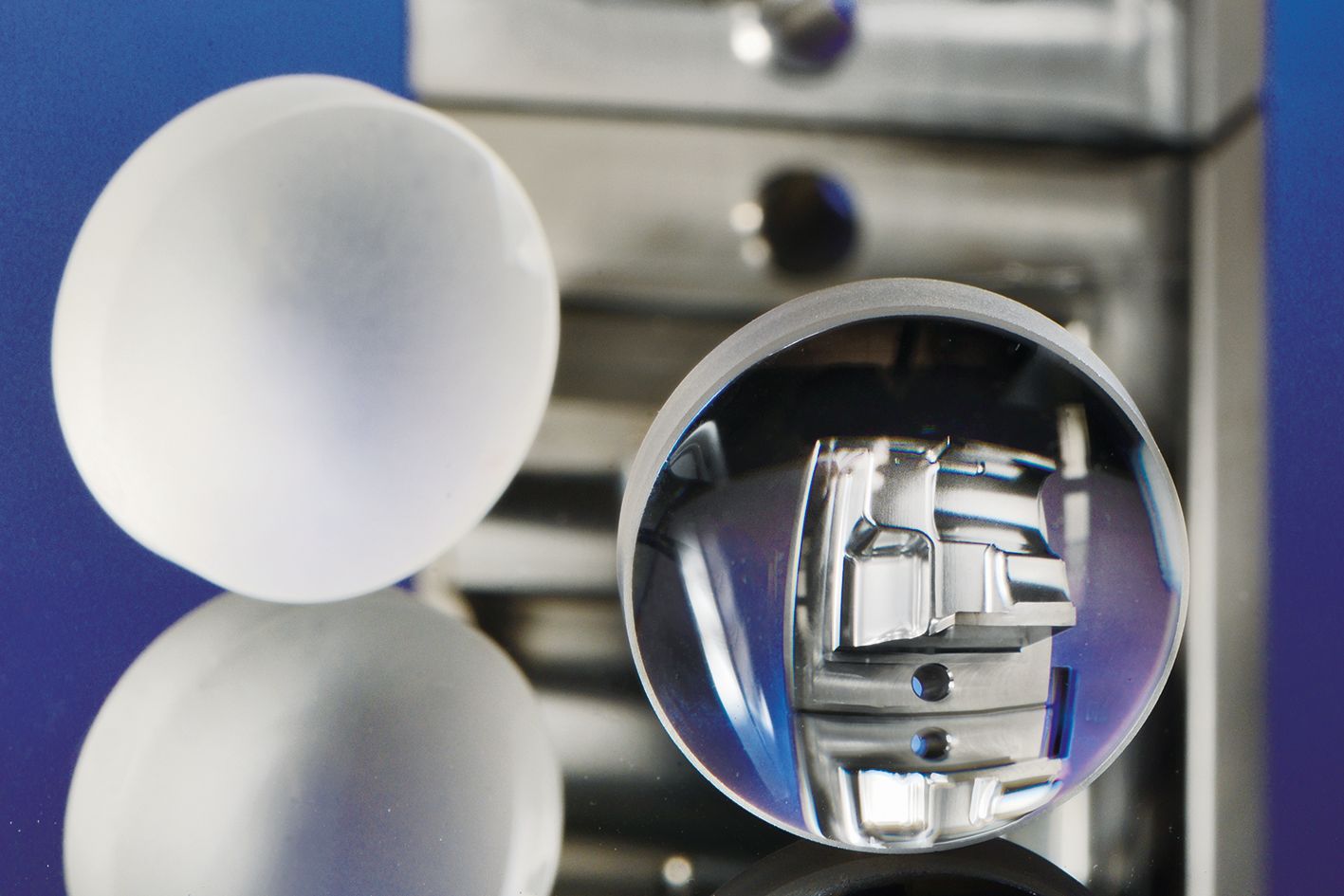The vision of purely photonic process chains in optics production is becoming a reality. “It is now foreseeable that lasers will develop their potential along the entire process chain, from shaping and polishing to shape correction,” says Dr. Edgar Willenborg, Group Leader of Polishing at Fraunhofer ILT in Aachen. In initial industrial applications, laser-based processes will complement established mechanical processes. The driver of this development is the increasing demand for complex aspheres and free-form optics specifically designed for individual applications. Their production is pushing mechanical manufacturing processes to their limits since these conventional methods are usually optimized for processing spherical – i.e. semi-circular – lenses.
Shaping, polishing and correcting the more complex aspheres mechanically is time-consuming and costly. This is where freely programmable, non-contact laser processes have a distinct advantage. There is no need to use shaping tools or polishing agents. The laser processes also leave chemically clean surfaces. “And thanks to the numerically controlled processes which do not need forming tools, the processing times are no longer dependent on the lens shape,” explains Willenborg.
New specialist conference focuses on laser-based optics production
There are still a number of challenges to overcome before laser-based manufacturing processes can be widely used for optics. In particular, the required dimensional accuracy and the extensive range of materials for glass and polymer optics pose unresolved issues. Fraunhofer ILT is launching a new specialist conference to address these issues in a targeted and timely manner with an international specialist community from research and industry: The “1st Conference on Laser-based Optics Manufacturing LOM” will take place from October 15 to 16, 2024 in combination with the “6th Conference on Laser Polishing LaP” at the Aachen-based institute. In addition to 20 lectures, the combined conference will offer an extensive laboratory tour, a showcase and poster exhibition and various discussion and networking formats. “Because we are expecting a highly specialized international community from research and industry, both conferences will be held in English,” explains Willenborg. As the aim is to transfer know-how to industrial applications, the majority of presentations will be given by researchers.
In technical terms, LOM will focus on photonic process chains whose shaping is based on ablation using ultrashort pulse (USP) lasers and Selective Laser-induced Etching (SLE). CO2 lasers are used for polishing. Their beam melts the surface of the glass or plastic lenses to a depth of 10 µm. In this zone, the material transforms into a honey-like state and then automatically smoothes out as it cools thanks to the surface tension. “As the surface layer remelts and the surface is smoothed by the interfacial tension, outstanding surface qualities result,” emphasizes the Fraunhofer ILT expert. The roughness in the sub-nanometer range sets new standards and predestines the laser processes for applications that require the highest optical performance. Laser processes are already being used to remove micro-roughness, which scatter light and make surfaces appear cloudy, and complement process chains that were previously still mechanically dominated.
Laser polishing as an enabler in the future market of laser inertial confinement fusion
The new specialist conference will focus, among others, on optical surfaces with high damage thresholds. Four presentations will shed light on the potential of laser processes for increasing optical damage thresholds. These include a presentation by the California Lawrence Livermore National Laboratory (LLNL), whose National Ignition Facility (NIF) succeeded in igniting a plasma under laboratory conditions for the first time in human history in December 2022, triggering the fusion of the hydrogen isotopes deuterium and tritium. This released more energy than was required for ignition by laser. The NIF operates the world's largest, highest-energy laser system with 192 beam paths, over two megajoules of pulse energy and 500 terawatts of peak power. The high-energy UV laser pulses regularly bring optical components to the edge of the destruction threshold, and beyond. Laser polishing is a promising approach to making these components more robust. This is because, unlike mechanical processes, it does not leave any micro-defects in the lens surface.
The “6th Conference on Laser Polishing LaP” will focus on the laser polishing of metals, glass, plastics and other materials. It will look in greater detail on functional and design surfaces as well as the post-treatment of complex additively manufactured components. Here, too, non-contact laser processes have advantages over mechanical processes owing to the often complex component geometries.
“With their respective range of topics, both conferences are unique worldwide,” emphasizes Willenborg. There are no separate specialist conferences for either laser-based optics production or laser polishing. Precisely because these young fields of technology are developing very dynamically, Fraunhofer ILT is focusing on early knowledge transfer. “Companies that are already taking advantage of modern laser polishing processes can gain real competitive advantages,” he says. In addition, networking within the scientific community is also important to identify synergies in research and jointly leverage them in the interests of rapid progress.
 Fraunhofer Institute for Laser Technology ILT
Fraunhofer Institute for Laser Technology ILT
